How Global Climate Change Affects Human Health
 On This Page:
On This Page:
Overview
The impacts of climate change include warming temperatures, changes in precipitation, increases in the frequency or intensity of some farthermost weather condition events, and ascension sea levels. These impacts threaten our wellness by affecting the food we swallow, the h2o we potable, the air we breathe, and the conditions nosotros experience.
The severity of these health risks volition depend on the power of public wellness and safety systems to address or prepare for these changing threats, also as factors such as an individual's behavior, age, gender, and economic status. Impacts will vary based on a where a person lives, how sensitive they are to health threats, how much they are exposed to climatic change impacts, and how well they and their community are able to conform to alter.
People in developing countries may be the most vulnerable to health risks globally, but climate change poses significant threats to health fifty-fifty in wealthy nations such as the Usa. Certain populations, such as children, pregnant women, older adults, and people with low incomes, confront increased risks; see the section beneath on Populations of Business organisation.
Top of Folio
Temperature-Related Impacts
Warmer boilerplate temperatures will lead to hotter days and more frequent and longer rut waves.[2] These changes volition atomic number 82 to an increase in rut-related deaths in the United States—reaching as much as thousands to tens of thousands of additional deaths each year by the cease of the century during summer months.
These deaths will not be offset by the smaller reduction in cold-related deaths projected in the wintertime months.[1] However, adaptive responses, such as wider use of air conditioning, are expected to reduce the projected increases in death from farthermost heat.[1]
Click the epitome to view a larger version.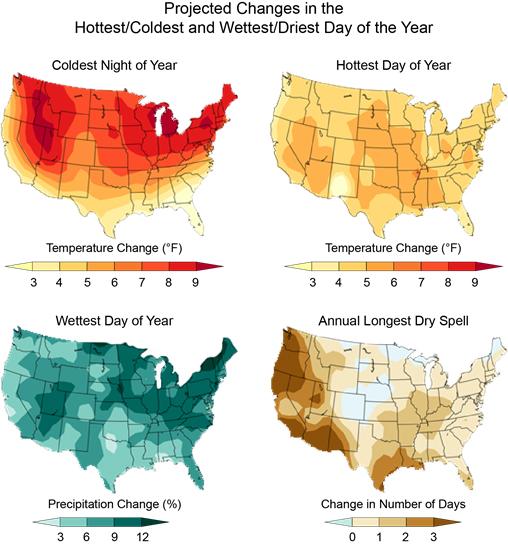 Projected changes in several climate variables for 2046-2065 with respect to the 1981-2000 average for the RCP6.0 scenario. These include the coldest dark of the twelvemonth (summit left) and the hottest twenty-four hour period of the year (meridian right). By the eye of this century, the coldest nighttime of the year is projected to warm by 6°F to 10°F over most of the country, with slightly smaller changes in the south. The warmest 24-hour interval of the yr is projected to be 4°F to 6°F warmer in about areas. Besides shown are projections of the wettest day of the year (lesser left) and the annual longest sequent dry mean solar day spell (bottom right). Extreme precipitation is projected to increase, with an boilerplate change of v% to xv% in the precipitation falling on the wettest day of the year. The length of the annual longest dry spell is projected to increase in well-nigh areas, just these changes are minor: less than ii days in about areas.[one]
Projected changes in several climate variables for 2046-2065 with respect to the 1981-2000 average for the RCP6.0 scenario. These include the coldest dark of the twelvemonth (summit left) and the hottest twenty-four hour period of the year (meridian right). By the eye of this century, the coldest nighttime of the year is projected to warm by 6°F to 10°F over most of the country, with slightly smaller changes in the south. The warmest 24-hour interval of the yr is projected to be 4°F to 6°F warmer in about areas. Besides shown are projections of the wettest day of the year (lesser left) and the annual longest sequent dry mean solar day spell (bottom right). Extreme precipitation is projected to increase, with an boilerplate change of v% to xv% in the precipitation falling on the wettest day of the year. The length of the annual longest dry spell is projected to increase in well-nigh areas, just these changes are minor: less than ii days in about areas.[one]
Exposure to extreme estrus tin lead to heat stroke and dehydration, as well every bit cardiovascular, respiratory, and cerebrovascular disease.[three][4] Excessive estrus is more likely to affect populations in northern latitudes where people are less prepared to cope with excessive temperatures. Certain types of populations are more than vulnerable than others: for example, outdoor workers, student athletes, and homeless people tend to be more exposed to extreme heat because they spend more than time outdoors. Low-income households and older adults may lack access to air conditioning which also increases exposure to extreme heat. Additionally, immature children, pregnant women, older adults, and people with certain medical conditions are less able to regulate their body temperature and can therefore be more vulnerable to extreme heat.[1]
Man Health Risks in Your Land
Our interactive map features climate-related health risks by state and actions yous can accept to reduce these risks.
Urban areas are typically warmer than their rural surround. Large metropolitan areas such as St. Louis, Philadelphia, Chicago, and Cincinnati take seen notable increases in death rates during heat waves.[2] Climatic change is projected to increment the vulnerability of urban populations to heat-related health impacts in the future. Heat waves are also frequently accompanied past periods of stagnant air, leading to increases in air pollution and associated health effects.[2]
Click the epitome to view a larger version.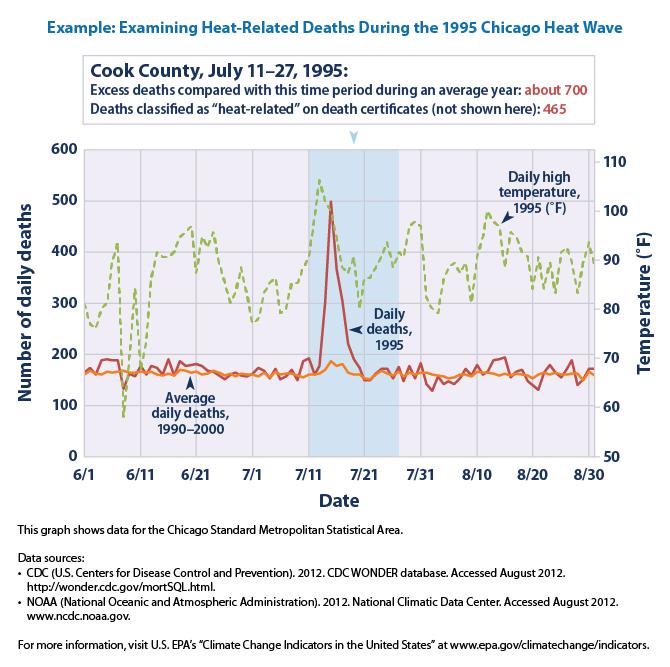 This figure shows the relationship betwixt high temperatures and deaths observed during the 1995 Chicago heat wave. The large fasten in deaths in mid-July (blood-red line) is much higher than the average number of deaths during that time of year (orange line), likewise as the death rate before and afterwards the heat wave. Source: EPA (2014)
This figure shows the relationship betwixt high temperatures and deaths observed during the 1995 Chicago heat wave. The large fasten in deaths in mid-July (blood-red line) is much higher than the average number of deaths during that time of year (orange line), likewise as the death rate before and afterwards the heat wave. Source: EPA (2014)
Top of Page
Air Quality Impacts
Changes in the climate impact the air we exhale both indoors and outdoors. Warmer temperatures and shifting weather patterns can worsen air quality, which can lead to asthma attacks and other respiratory and cardiovascular health furnishings.[1] Wildfires, which are expected to continue to increase in number and severity every bit the climate changes, create smoke and other unhealthy air pollutants.[1] Rising carbon dioxide levels and warmer temperatures also affect airborne allergens, such every bit ragweed pollen.
Despite significant improvements in U.S. air quality since the 1970s, as of 2014 about 57 million Americans lived in counties that did non encounter national air quality standards.[5] Climatic change may make information technology fifty-fifty harder for states to meet these standards in the hereafter, exposing more people to unhealthy air.
Increases in Ozone
Scientists project that warmer temperatures from climate change will increase the frequency of days with unhealthy levels of ground-level ozone, a harmful air pollutant, and a component in smog.[i]
- People exposed to college levels of ground-level ozone are at greater risk of dying prematurely or being admitted to the hospital for respiratory problems.[1]
- Basis-level ozone tin can harm lung tissue, reduce lung function, and inflame airways. This can aggravate asthma or other lung diseases. Children, older adults, outdoor workers, and those with asthma and other chronic lung diseases are especially at chance.[v]
-
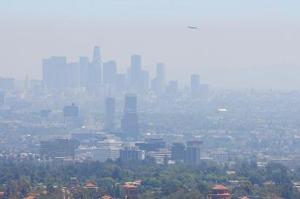 Smog in Los Angeles decreases visibility and can be harmful to homo health. Source: California Air Resource Board (2014) Because warm, stagnant air tends to increase the formation of ozone, climatic change is likely to increment levels of footing-level ozone in already-polluted areas of the United States and increase the number of days with poor air quality.[ane]
Smog in Los Angeles decreases visibility and can be harmful to homo health. Source: California Air Resource Board (2014) Because warm, stagnant air tends to increase the formation of ozone, climatic change is likely to increment levels of footing-level ozone in already-polluted areas of the United States and increase the number of days with poor air quality.[ane] - The college concentrations of ozone due to climate alter may result in tens to thousands of additional ozone-related illnesses and premature deaths per yr by 2030 in the Us, assuming no change in projected air quality policies.[1]
Changes in Particulate Affair
Particulate affair is the term for a category of extremely pocket-size particles and liquid droplets suspended in the atmosphere. Fine particles include those smaller than 2.5 micrometers (about 1 ten-thousandth of an inch). Some particulate matter such every bit dust, wildfire smoke, and sea spray occur naturally, while some is created by homo activities such as the called-for of fossil fuels to produce energy. These particles may be emitted directly or may be formed in the atmosphere from chemic reactions of gases such equally sulfur dioxide, nitrogen dioxide, and volatile organic compounds.
- Inhaling fine particles tin lead to a wide range of adverse health furnishings, including lung cancer, chronic obstructive pulmonary disease (COPD), and cardiovascular disease.[1]
- Climate change is expected to increase the number and severity of wildfires. Particulate thing from wildfire smoke can oftentimes be carried very long distances by the current of air, affecting people who live far from the source of this air pollutant.
- Older adults are particularly sensitive to brusk-term particle exposure, with a higher take chances of hospitalization and expiry.[ane] Outdoor workers like firefighters tin can also take high exposure.
Due to the complex factors that influence atmospheric levels of fine particulate affair, scientists do not yet know whether climate alter volition increase or decrease particulate matter concentrations across the U.s.a..[ane][half dozen][vii] Particulate matter can be removed from the air by rainfall, and precipitation is expected to increase in quantity though not necessarily frequency. Climate-related changes in brackish air episodes, current of air patterns, emissions from vegetation and the chemical science of atmospheric pollutants will also affect particulate matter levels.[ane]
Climate Change and Human Health Quiz
Think yous have what it takes to score 100%? Take our quiz to see how much you know about the health impacts of climate change!
Changes in Allergens and Asthma Triggers
Allergic illnesses, including hay fever, affect about one-third of the U.S. population, and more than than 34 million Americans have been diagnosed with asthma.[1] Climate change may affect allergies and respiratory health.[1] The spring pollen flavour is already occurring earlier in the U.s. for certain types of plants, and the length of the season has increased for some plants with highly allergenic pollen such equally ragweed.[ane] In addition to lengthening the ragweed pollen flavour, rising carbon dioxide concentrations and temperatures may as well lead to earlier flowering, more flowers, and increased pollen levels in ragweed.[one][4]
Top of Page
Impacts from Extreme Weather Events
Increases in the frequency or severity of some extreme weather events, such equally extreme precipitation, flooding, droughts, and storms, threaten the health of people during and subsequently the event.[ane] The people most at risk include young children, older adults, people with disabilities or medical conditions, and the poor. Extreme events tin bear on human being health in a number of ways by:
-
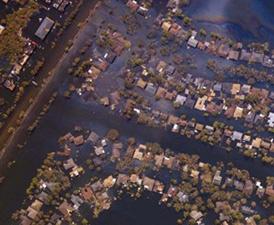 Hurricane Katrina was one of the most devastating hurricanes in the U.s.a., responsible for an estimated 971 to 1,300 deaths. Source: NOAA Reducing the availability of safety nutrient and drinking water.[1]
Hurricane Katrina was one of the most devastating hurricanes in the U.s.a., responsible for an estimated 971 to 1,300 deaths. Source: NOAA Reducing the availability of safety nutrient and drinking water.[1] - Damaging roads and bridges, disrupting access to hospitals and pharmacies.[1]
- Interrupting communication, utility, and wellness care services.[1]
- Contributing to carbon monoxide poisoning from improper use of portable electric generators during and after storms.[i]
- Increasing tummy and intestinal disease, particularly following power outages.[ane]
- Creating or worsening mental wellness impacts such as depression and post-traumatic stress disorder (PTSD).[1]
In improver, emergency evacuations pose health risks to older adults, particularly those with limited mobility who cannot use elevators during power outages. Evacuations may be complicated by the need for concurrent transfer of medical records, medications, and medical equipment. Some individuals with disabilities may also be disproportionally affected if they are unable to access evacuation routes, accept difficulty in understanding or receiving warnings of impending danger, or have express ability to communicate their needs.
Summit of Folio
Vectorborne Diseases
Vectorborne diseases are illnesses that are transmitted by illnessvectors, which include mosquitoes, ticks, and fleas. These vectors can carry infectious pathogens, such as viruses, bacteria, and protozoa, from animals to humans. Changes in temperature, precipitation, and extreme events increases the geographic range of diseases spread by vectors and can lead to illnesses occurring before in the yr.
- The geographic range of ticks that acquit Lyme disease is limited by temperature. As air temperatures ascension, ticks are likely to become active earlier in the flavour, and their range is likely to continue to aggrandize n.[i] Typical symptoms of Lyme disease include fever, headache, fatigue, and a characteristic peel rash.
- Mosquitoes thrive in certain climate atmospheric condition and tin spread diseases like West Nile virus. Extreme temperatures—too common cold, hot, wet, or dry—influence the location and number of mosquitoes that transmit West Nile virus. More than than three million people were estimated to be infected with West Nile virus in the The states from 1999 to 2010.[one]
The spread of climate-sensitive diseases will depend on both climate and non-climate factors such equally land apply, socioeconomic and cultural conditions, pest command, access to wellness intendance, and human responses to affliction chance. The U.s.a. has public health infrastructure and programs to monitor, manage, and prevent the spread of many diseases. The risks for climate-sensitive diseases can be much higher in poorer countries that take less chapters to foreclose and treat affliction.[8]
Click the prototype to view a larger version.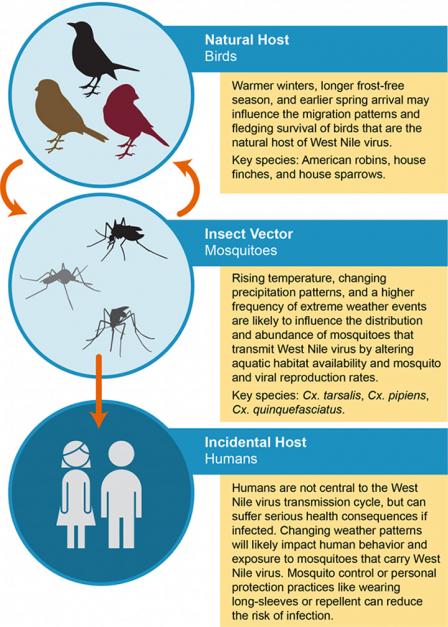 West Nile virus is maintained in manual cycles between birds (the natural hosts of the virus) and mosquitoes. Human infections can occur from a bite of a mosquito that has previously bitten an infected bird. Warmer winters, longer frost-gratis season, and before spring arrival may influence the migration patterns and fledgling survival of birds that are the natural host of West Nile virus. In add-on, rising temperature, changing precipitation patterns, and a college frequency of farthermost weather condition events are probable to influence the distribution and abundance of mosquitoes that transmit West Nile virus. Source: USGCRP (2016)
West Nile virus is maintained in manual cycles between birds (the natural hosts of the virus) and mosquitoes. Human infections can occur from a bite of a mosquito that has previously bitten an infected bird. Warmer winters, longer frost-gratis season, and before spring arrival may influence the migration patterns and fledgling survival of birds that are the natural host of West Nile virus. In add-on, rising temperature, changing precipitation patterns, and a college frequency of farthermost weather condition events are probable to influence the distribution and abundance of mosquitoes that transmit West Nile virus. Source: USGCRP (2016)
Peak of Page
H2o-Related Illnesses
People can get sick if exposed to contaminated drinking or recreational water. Climate modify increases the take a chance of illness through increasing temperature, more than frequent heavy rains and runoff, and the effects of storms. Wellness impacts may include gastrointestinal affliction like diarrhea, furnishings on the trunk'southward nervous and respiratory systems, or liver and kidney damage.[ane]
- Climate impacts can touch exposure to waterborne pathogens (bacteria, viruses, and parasites such every bitCryptosporidium andGiardia); toxins produced by harmful algal and cyanobacterial blooms in the water; and chemicals that end upwards in h2o from human activities.[1]
- Changing water temperatures mean that waterborneVibrio bacteria and harmful algal toxins volition exist nowadays in the h2o or in seafood at dissimilar times of the yr, or in places where they were non previously threats.[ane]
- Runoff and flooding resulting from increases in extreme precipitation, hurricane rainfall, and storm surge volition increasingly contaminate water bodies used for recreation (such as lakes and beaches), shellfish harvesting waters, and sources of drinking water.[1]
- Extreme atmospheric condition events and storm surges can damage or exceed the capacity of water infrastructure (such equally drinking water or wastewater treatment plants), increasing the run a risk that people will be exposed to contaminants.[1]
Water resources, public health, and environmental agencies in the United states provide many public health safeguards to reduce run a risk of exposure and illness even if water becomes contaminated. These include water quality monitoring, drinking h2o treatment standards and practices, beach closures, and issuing advisories for boiling drinking h2o and harvesting shellfish.
Acme of Page
Nutrient Safety and Nutrition
Climate change and the direct impacts of college concentrations of carbon dioxide in the temper are expected to bear on food safety and nutrition.[1] Extreme weather events can also disrupt or slow the distribution of food.[1]
- Higher air temperatures can increase cases ofSalmonella and other bacteria-related nutrient poisoning because leaner grow more than chop-chop in warm environments. These diseases tin cause gastrointestinal distress and, in severe cases, death.[1] Practices to safeguard food tin can help avoid these illnesses even equally the climate changes.
- Climate change will have a diverseness of impacts that may increment the take a chance of exposure to chemical contaminants in nutrient. For instance, higher sea surface temperatures will lead to higher mercury concentrations in seafood, and increases in extreme weather events will innovate contaminants into the food chain through stormwater runoff.[one]
- Higher concentrations of carbon dioxide in the air can act as a "fertilizer" for some plants, simply lowers the levels of protein and essential minerals in crops such as wheat, rice, and potatoes, making these foods less nutritious.[one]
- Extreme events, such equally flooding and drought, create challenges for nutrient distribution if roads and waterways are damaged or made inaccessible.
Click the image to view a larger version.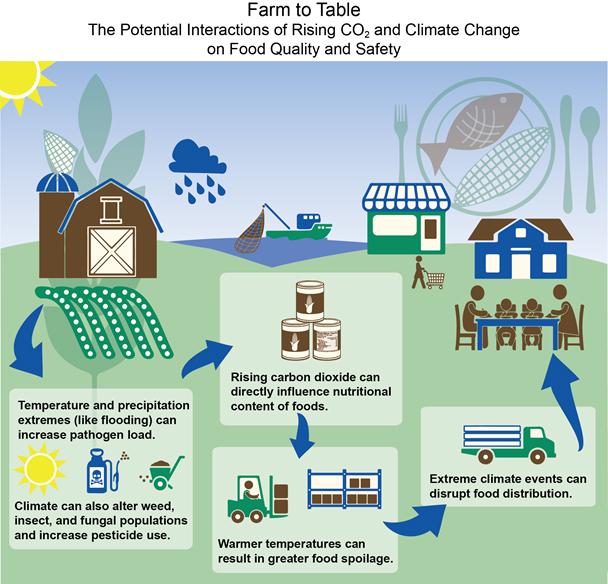 The nutrient system involves a network of interactions with our physical and biological environments as nutrient moves from production to consumption, or from "subcontract to table." Rising CO2 and climatic change will affect the quality and distribution of food, with subsequent effects on food safety and nutrition. Source: USGCRP (2016)
The nutrient system involves a network of interactions with our physical and biological environments as nutrient moves from production to consumption, or from "subcontract to table." Rising CO2 and climatic change will affect the quality and distribution of food, with subsequent effects on food safety and nutrition. Source: USGCRP (2016)
Top of Page
Mental Wellness
Whatsoever changes in a person's physical health or surrounding surround tin as well have serious impacts on their mental wellness. In detail, experiencing an extreme conditions result tin can cause stress and other mental health consequences, particularly when a person loses loved ones or their domicile.[one]
- Individuals with mental illness are especially vulnerable to extreme estrus; studies have found that having a pre-existing mental illness tripled the risk of decease during heat waves.[ane] People taking medication for mental affliction that makes information technology hard to regulate their trunk temperature are particularly at chance.
- Even the perceived threat of climatic change (for example from reading or watching news reports about climate change) can influence stress responses and mental health.[i]
- Some groups of people are at college risk for mental health impacts, such as children and older adults, pregnant and post-partum women, people with pre-existing mental illness (see above), people with low incomes, and emergency workers.[1]
Top of Page
Populations of Business organisation
Climate and Health Factsheets
Learn nearly how climate modify will bear on your wellness over the form of your life, and see its impacts on eight different populations of business organisation.
View the factsheets »
Some groups of people are more vulnerable than others to health risks from climate change.[1] Three factors contribute to vulnerability:sensitivity, which refers to the degree to which people or groups are affected past a stressor such as higher temperatures;exposure, which refers to physical contact between a person and a stressor; andadaptive capacity, which refers to an ability to adapt to or avoid potential hazards. For example, while older adults are sensitive to extreme rut, an older person living in an air-conditioned apartment won't be exposed equally long as she stays indoors, and as long as she can afford to pay for the electricity to run the air conditioner. Her ability take these actions is a measure of her adaptive capacity.
Some populations are especially vulnerable to climate health risks due to detail sensitivities, high likelihood of exposure, low adaptive capacity, or combinations of these factors.
- Communities of color (including Indigenous communities also equally specific racial and indigenous groups), low income, immigrants, and limited English language proficiency face disproportionate vulnerabilities due to a wide variety of factors, such as higher risk of exposure, socioeconomic and educational factors that affect their adaptive chapters, and a college prevalence of medical conditions that affect their sensitivity.[ane]
- Children are vulnerable to many health risks due to biological sensitivities and more than opportunities for exposure (due to activities such as playing outdoors). Pregnant women are vulnerable to heat waves and other extreme events, like flooding.[1]
- Older adults are vulnerable to many of the impacts of climatic change. They may have greater sensitivity to heat and contaminants, a higher prevalence of disability or preexisting medical weather, or limited financial resources that go far hard to adapt to impacts.[1]
- Occupational groups, such every bit outdoor workers, paramedics, firefighters, and transportation workers, also as workers in hot indoor piece of work environments, will exist especially vulnerable to extreme heat and exposure to vectorborne diseases.[1]
- People with disabilities can be very vulnerable during farthermost weather events, unless communities ensure that their emergency response plans specifically adjust them.
- People with chronic medical conditions are typically vulnerable to extreme heat, specially if they are taking medications that go far hard to regulate torso temperature.[1] Power outages can be particularly threatening for people reliant on certain medical equipment.
Top of Folio
Other Wellness Impacts
Other linkages exist between climate change and human wellness. For instance, changes in temperature and precipitation, as well every bit droughts and floods, will touch on agricultural yields and product.[9] In some regions of the world, these impacts may compromise food security and threaten homo wellness through malnutrition, the spread of infectious diseases, and food poisoning. The worst of these effects are projected to occur in developing countries, among vulnerable populations.[8] Declines in human health in other countries can affect the United States through trade, migration, and immigration and has implications for national security.[1][4]
Although the impacts of climate change have the potential to affect man health in the United states of america and around the globe, there is a lot we can do to prepare for and accommodate to these changes—such every bit establishing early warning systems for heat waves and other extreme events, taking steps to reduce vulnerabilities amid populations of business concern, raising sensation amid healthcare professionals, and ensuring that infrastructure is built to accommodate anticipated time to come changes in climate. Understanding the threats that climate change poses to homo health is the first stride in working together to lower risks and be prepared.
Pinnacle of Page
References
1. USGCRP (2016).Impacts of Climate Change on Man Health in the United States: A Scientific Cess. Crimmins, A., J. Balbus, J.L. Risk, C.B. Beard, J.E. Bell, D. Dodgen, R.J. Eisen, North.Fann, Thousand.D. Hawkins, S.C. Herring, L. Jantarasami, D.1000. Mills, S. Saha, Thou.C. Sarofim, J.Trtanj, and L.Ziska, Eds. U.S. Global Modify Research Program, Washington, DC. 312 pp. dx.doi.org/10.7930/J0R49NQX.
two. USGCRP (2016). Luber, G., Thou. Knowlton, J. Balbus, H. Frumkin, M. Hayden, J. Hess, M. McGeehin, N. Sheats, 50. Capitalist, C. B. Beard, K. L. Ebi, E. Maibach, R. South. Ostfeld, C. Wiedinmyer, East. Zielinski-Gutiérrez, and L. Ziska, 2014:Ch. ix: Homo Health. Climate Change Impacts in the U.s.a.: The Third National Climate Assessment, J. Yard. Melillo, Terese (T.C.) Richmond, and 1000. Westward. Yohe, Eds., U.S. Global Change Research Program, 220-256. doi:10.7930/J0PN93H5.
three. USGCRP (2009).Global Climate Change Impacts in the United States. Karl, T.R., J.M. Melillo, and T.C. Peterson (eds.). United States Global Alter Research Program. Cambridge University Press, New York, NY, USA.
four. CCSP (2008).Analyses of the effects of global modify on man health and welfare and human systems. A Report by the U.S. Climate Change Science Program and the Subcommittee on Global Change Enquiry. Hazard, J.L. (ed.), One thousand.50. Ebi, F.G. Sussman, T.J. Wilbanks, (Authors). U.S. Environmental Protection Agency, Washington, DC, United states of america.
v. EPA (2014). Air Quality Trends. Accessed March 1, 2016.
6. NRC (2010).Advancing the Science of Climatic change. National Research Quango. The National Academies Printing, Washington, DC, United states of america.
7. EPA (2009).Assessment of the Impacts of Global Change on Regional U.Southward. Air Quality: A Synthesis of Climatic change Impacts on Ground-Level Ozone (An Interim Report of the U.Due south. EPA Global Change Research Programme). U.S. Environmental Protection Bureau, Washington, DC, Us.
8. IPCC (2014).Climate Modify 2014: Synthesis Report.Contribution of Working Groups I, II and III to the Fifth Assessment Report of the Intergovernmental Panel on Climate change [Core Writing Team, R.K. Pachauri and L.A. Meyer (eds.)]. IPCC, Geneva, Switzerland, 151 p. (PDF, eighty pp, four.6MB).
9. USDA (2015).Climatic change, Global Food Security, and the U.South. Food System. Brown, Grand.Due east., J.M. Antle, P. Backlund, East.R. Carr, West.E. Easterling, M.K. Walsh, C. Ammann, W. Attavanich, C.B. Barrett, Grand.F. Bellemare, V. Dancheck, C. Funk, Thou. Grace, J.S.I. Ingram, H. Jiang, H. Maletta, T. Mata, A. Murray, M. Ngugi, D. Ojima, B. O'Neill, and C. Tebaldi, 146 p.
Height of Page
Source: https://19january2017snapshot.epa.gov/climate-impacts/climate-impacts-human-health
Posted by: stephensbeforpeo.blogspot.com

0 Response to "How Global Climate Change Affects Human Health"
Post a Comment